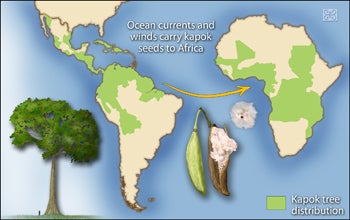Research themes and highlights
 Biogeography. I have been intrigued by floristic similarities among tropical rain forests that are separated by major biogeographic barriers. A prominent example is provided by the rain forests in Africa and South America, which are similar in taxonomic composition despite their physical separation by the Atlantic Ocean for nearly 100 million years. Our studies of the amphi-Atlantic tree species Ceiba pentandra (Kapok tree) and Symphonia globulifera highlighted the role of sweepstakes dispersal in generating trans-oceanic patterns. Ceiba pentandra dispersed naturally from neotropical forests to Africa over a very recent (but Pre-Columbian) time scale. In the case of Symphonia globulifera a combination of fossil records and a well-resolved phylogeny reveal multiple dispersal events from Africa to the Neotropics during the mid-Miocene (around 15 million years ago). These dispersal events took place despite the fact that S. globulifera is a shade-tolerant species with no adaptations for wind or water dispersal. Both case studies highlight the importance of long distance dispersal in homogenizing rain forest tree communities across major geographic barriers.
Biogeography. I have been intrigued by floristic similarities among tropical rain forests that are separated by major biogeographic barriers. A prominent example is provided by the rain forests in Africa and South America, which are similar in taxonomic composition despite their physical separation by the Atlantic Ocean for nearly 100 million years. Our studies of the amphi-Atlantic tree species Ceiba pentandra (Kapok tree) and Symphonia globulifera highlighted the role of sweepstakes dispersal in generating trans-oceanic patterns. Ceiba pentandra dispersed naturally from neotropical forests to Africa over a very recent (but Pre-Columbian) time scale. In the case of Symphonia globulifera a combination of fossil records and a well-resolved phylogeny reveal multiple dispersal events from Africa to the Neotropics during the mid-Miocene (around 15 million years ago). These dispersal events took place despite the fact that S. globulifera is a shade-tolerant species with no adaptations for wind or water dispersal. Both case studies highlight the importance of long distance dispersal in homogenizing rain forest tree communities across major geographic barriers.
Community Assembly I have been interested in quantifying the role of intercontinental migrations in structuring regional species pools of tropical trees. Pennington and Dick (2004, 2010) analyzed the historical biogeography of tree species in the Yasuní 50-ha forest inventory plot in Ecuador. Using fossil-dated phylogenies, we deduced that more than 30% of the 1104 tree species are from immigrant lineages, i.e. lineages that originated outside of South America, entering the Amazon basin either through the Isthmus of Panama or via oceanic currents. This result contrasted with the long held view that most Amazon tree lineages originated in South America while it was still connected to Africa.
Comparative phylogeography In the forests of Panama, approximately 60% of the tree species (>400 species) extend into the Amazon basin, despite the existence for several million of the migration barrier posed by the northern Andean cordilleras. In the Andean country of Ecuador, approximately 30% of the lowland flora (>1400 species) occurs east and west of the Andes. Have these widespread species remained morphologically conserved since before the uplift of the Andes, or have they been able to disperse around the Andes more recently? To address these questions, the lab examines DNA sequence variation and morphological divergence in widespread species, and examines divergence times of geographic populations.
Plant-animal interactions In tropical moist forests up to 99% of the tree species rely on animals for pollination, and the majority of species are dispersed by animals. For some species, it is not clear if seed or pollen is the major vector of gene flow, or how hunting or habitat fragmentation will alter gene flow processes in remnant plant populations. Furthermore, we know little about how biotic interactions (herbivory, competition, pathogens) impact the spatial and genetic structure of tropical trees. Members of my lab are developing genetic markers and performing field studies of a variety of tropical tree groups in order to understand how biotic interactions impact evolutionary processes in tropical tree populations.
